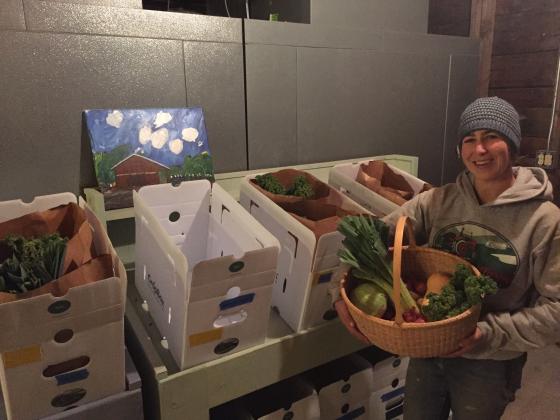Posted December 1, 2017 at 05:57am by Sophia Veltrop
Sweetland Farm in Norwich Grows their Business

Norah Lake and Chris Polashenski of Sweetland Farm are expanding their business to serve more customers in the Upper Valley. To make this happen, the couple bought an adjacent 32-acre parcel from Jessica and Edward Polashenski, Chris’s parents, who conserved it with the Vermont Land Trust. The sale of the development rights helped Chris and Norah buy the land at its more affordable, agricultural value.
Over the course of just a few years, the couple has built a prominent vegetable, livestock, and hay business from scratch. The couple bought their property on Route 132 through the Vermont Land Trust’s Farmland Access Program, which connects entrepreneurial farmers with land for their businesses. Their farm is protected through the land trust; it cannot be developed or subdivided, and will stay available for future farmers.
Sweetland Farm’s weekly organic produce share serves 180 families in the Upper Valley. Members pick up their boxes of fresh veggies at the farmstead, flanked by greenhouses and a large white barn to the west and, to the east, a pick-your-own garden of flowers and herbs. Others visit the on-farm store to buy Sweetland Farm’s pasture-raised pork, lamb, or chicken, along with eggs, honey, and maple syrup from other local farms.
The soils on the farm’s new land are an excellent fit for growing vegetables, and will allow for more room to rotate crops.
“This is a realization of what we’ve been hoping for since our original business plan,” said Norah. “The extra parcel will help us meet our goal of adding 50 more CSA shares.” She is also planning to increase their sales by renovating the farm store and offering wholesale orders to restaurants.
The new property is an outstanding resource for aquatic wildlife. The Ompompanoosuc River meanders along the eastern boundary of the property, while one of its tributaries flows across the property from the west. These waterways and their wetlands are now protected and will continue to provide valuable habitat for plants and animals, including the wood turtle, an uncommon reptile in Vermont.
This conservation project was made possible with funding from the Forrest & Frances Lattner Foundation and the Vermont Housing & Conservation Board (VHCB), with matching funds from USDA Natural Resources Conservation Service. The financial assistance from VHCB and NRCS help make it possible for Vermont to permanently protect Vermont’s highest quality agricultural resources.
